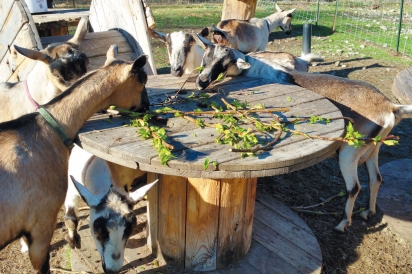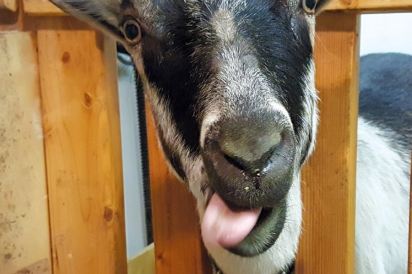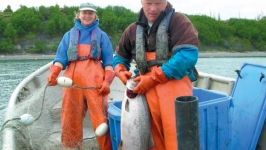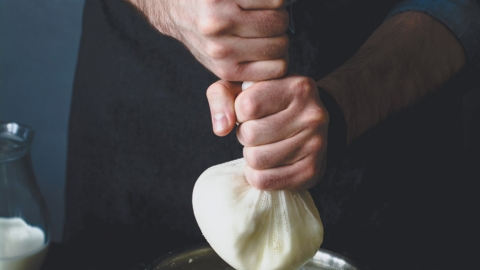Meet the Goats of Wasilla's Cottonwood Creek Farm
An Alaska goat milk primer
My half gallon of fresh, raw Jersey cow milk sits on the kitchen counter, topped with three thick inches of sweet cream. I dip my spoon in once, twice, and again, eager to taste dairy as nature intended. I grew up drinking powdered milk and when visiting friends for dinner would gulp down two glasses of store-bought pasteurized. I never knew until I bought into a herd share in the Matanuska Valley several years ago just how delicious the real stuff is, unadulterated.
Friends who have never tried raw milk cautioned me about its safety, but I researched the facts, and I trusted my local farmer and her many long-time customers. I’ve received emails from the Department of Environmental Conservation’s Division of Environmental Health, warning of processed food recalls for undeclared allergens and possible salmonella. I’ve also seen alerts for packaged meals containing metal fragments. My raw milk seems eminently safer.
While the sale of raw milk to the general public in Alaska is illegal, herd shares are legal and thriving. Share owners pay a farmer to maintain the goats or cows and in exchange receive a portion of the milk production. It’s one way that Alaska’s dairy industry continues to innovate, despite the rough road it has traveled in the state.
Alaska Dairy 101
Just north of Juneau’s airport is a short neighborhood street named Lee Smith Drive. The Smith family owned just one of several dairies that cropped up to support miners after the city’s founding in 1880. Lee Smith is said to have ended up a dairy farmer by accident; while caretaking a friend’s cows, he received a telegram from the owner stating, “You can have the damned place.” The fertile meadows of the Mendenhall wetlands were prime land for grazing, and Juneau dairies survived until World War II, when the military gobbled up land for a runway and farming costs rose. The last Southeast dairy closed in 1965.
Another early commercial dairy sprang up in Fairbanks during that area’s gold rush in the early 1900s. Creamer’s Dairy, now Creamer’s Field Migratory Waterfowl Refuge, was the largest, offering a variety of milk products. Market pressures forced it to close in 1966. The operation’s historical buildings are listed on the National Park Service’s National Register of Historic Places.
As part of President Roosevelt’s New Deal of the 1930s, more than 200 Midwestern families moved to the Matanuska Valley and established farms. By 1947, thirty-three Grade A dairies sold milk in the region. Matanuska Maid, which started as a cooperative, rose to the top and thrived until 1983, when, overcome by debt and facing stiff competition from cheaper milk shipped from Outside, it filed for bankruptcy. The company enjoyed a rebound for several more years as a state-owned venture, but closed for good in 2007 after major financial losses.
Dairy farmers who’d bought into the state’s Point McKenzie land project in the 1980s with the mandate of providing raw milk for Matanuska Maid, feeding their cows barley grown in Delta Junction — also a state-subsidized scheme — floundered under debt. No dairies remain from this project.
Alaska’s only remaining dairy, Havemeister Dairy, is located near Palmer and has been in operation since 1935. The family-owned business sells their locally produced homogenized and pasteurized milk by the gallon at Carr’s-Safeway, Fred Meyer, Three Bears, and a few other stores around the state.
Get Your Goat Herd Share
Efforts to legalize the sale of raw milk continue. Many Alaskans involved in herd share activities — farmers, consumers, local food advocates — support legislation (HB 217, the “Food Freedom Act”) introduced in state government that would allow direct producer-to-consumer sales with appropriate labeling.
Right now, people that buy into goat or cow shares are only allowed to receive fluid milk from their animals. If they want yogurt, kefir, cheese, or ice cream from raw milk, they have to make it themselves. If passed, the Food Freedom Act would allow the sale of these additional raw milk products, among other fresh farm-related foods, directly to consumers. It would open up new markets for Alaska’s milk producers as well as bolster food security in a place otherwise dependent on weekly shipments from the West Coast.
Legalities aside, Alaska poses another big challenge for milk producers — the costs of feeding livestock. Suzy Crosby and Mike Pendergrast of Cottonwood Creek Farm in Wasilla buy several hundred bales of hay annually (at approximately $12/bale), plus feed their herd of American Alpine goats a no-corn/no-soy dairy ration that costs about $26 per 50-pound bag. A dozen high-producing milkers will consume a bag of that per day, along with about a bale and a half of hay, and 15 to 20 gallons of water. Their goats also have access to loose minerals and other supplements inside the pen. Alpines are winter-hardy, though, so a basic barn with bedding is all they need for shelter.
When I arrive at Cottonwood Creek Farm to meet “my” goats — I’ve decided to buy into a herd share again after a long hiatus — Suzy and Mike are busy with their morning milking. They repeat this task twice a day every day, even Christmas and New Year’s.
“Do you ever go on vacation?” I ask. I’m not surprised by Suzy’s answer: very rarely.
As Mike ushers Rhythm and Lexi out of the dedicated milking parlor and brings two more ladies in, I get to say hello to baby goats in another room. They mob me like puppies, tugging gently at my earlobe and trying to taste my hair.
Back in the milking room, Mike is hooking up the machine to the next pair. As soon as the does enter, they jump right up onto the platform, making their udders easy to reach. They know the routine. While the gals munch serenely on green pellets, Mike rubs their teats with a pre-wash containing tea tree oil and grapefruit seed extract, wipes the udders and teats clean, hand-strips a small amount of milk to visually inspect it, and then hooks up the machine.
Each pair produces about 10 pounds of milk — nearly a gallon and a half — in five minutes or so. Suzy pours the milk into clean half-gallon glass jars with plastic lids and places them into a cold running-water bath to start chilling the product immediately. Then she moves them into an ice water bath in the refrigerator. And finally, they go on the shelf above to stay cold until share owners either pick them up at the farm or from a prearranged location on a regular day and time. Suzy and Mike started at 8 a.m. When they’re done with milking and farm chores, it’ll be almost time for lunch. They’ll be back at it again in the evening.
> To learn more: State of Alaska: American Dairy Goat Association: adga.org; dec.alaska.gov/eh/vet/DairyMeat.html











